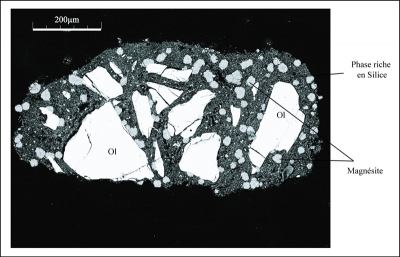
Thèses dans notre équipe
Origine et formation des diamants et de leurs inclusions de sulfure :
contribution à l’étude des processus géochimiques, des cycles (C, N et S) et de leur évolution dans le manteau supérieur terrestre.
sous la direction de Pierre Cartigny : soutenue le 7 décembre 2006


Traçage isotopique des sources et des puits de CO2 dans les réservoirs géologiques
sous la direction de Pierre Agrinier : soutenue le 4 décembre 2006
Etude expérimentale des réactions de carbonatation minérale du CO2 dans les roches basiques et ultrabasiques
sous la codirection d'Isabelle Martinez et de Guillaume Fiquet (Minéralogie) : soutenue le 8 novembre 2006
Mineral storage of CO2 is the process that converts gaseous CO2 into a carbonate phase stable over geological timescales. Carbonate formation upon interaction of CO2 with basic and ultrabasic rocks is an interesting option due to the good repartition of these rocks at the surface of the Earth and to the strong thermodynamic disequilibrium between the CO2-rich fluid and the constitutive minerals of these rocks.

We have carried out carbonatation experiments on olivine, serpentine and orthopyroxene under various conditions. Powders of these minerals are in contact with oxalic acid (H2C2O4 used as a source of CO2) in platinum capsules and then react at high pressure and temperature in an hydraulic press. Water and brines are introduced in some of the experiments to test their influence on the carbonatation reaction. After experiments, capsules are opened under vacuum to separate and quantify the different gases that were in contact with the silicates.
The amounts of carbonate formed were measured by decarbonatation of the reacted material. Chemical and isotopic mass balance calculations were also done in order to provide precise monitoring of carbonatation rates. Mineralogical study of the reacted samples using SEM and TEM allowed the identification of the mechanisms of carbonatation and the observation of magnesite crystals. Strong differences in carbonate textures and carbonatation rates were reported between NaCl-containing and NaCl-free samples. The measured carbonation rates in these systems strongly depend on the initial magnesium rich mineral. Pressure, temperature and molar fraction of CO2 in the gas phase are also key parameters. Additions of brines and water in the system increase the yield of the reactions. The conditions of temperature and pressure of these experiments, although far from planned CO2 storage conditions, allow to discuss thermodynamic aspects of these reactions.

Institut de Physique du Globe de Paris - Mise à jour 11/2024
Site publié avec e-Lectron - Contact : Webmaster IPGP